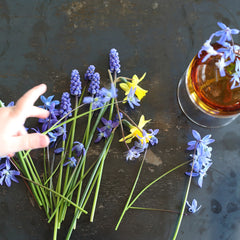

If you want a slightly different piece of art on your wall, here you will find inspiration to make your very own woven paper work. And you certainly don't need to know anything about the many facets of weaving to throw yourself into paper weaving - you can make your pattern as simple or as complicated as you want.
Paper weaving is basically about creating patterns, working with colors and creating different expressions. In exactly the same way as in the world of textiles, you can play with different motifs or keep the expression tighter with a geometric pattern.
And the project doesn't require much other than scissors and paper. Choosing colors, paper types and patterns are all artistic decisions and your opportunity to create a woven work that suits you and your home. Here we have played with transparent paper and the finished works have come in our new acrylic frames from the FRAMELESS collection. Here, the transparent paper gives the weaving an extra dimension - especially when the light is allowed to flow through.
Read along below, where we give you tips to get started with paper weaving.

3 TIPS FOR PAPER WEAVING
1. START SIMPLY
If it's the first time you're going to weave, it's a good idea to start with a smaller piece - maybe even just keep it in two colours. Then you can just get a feel for the craftsmanship before you get involved with more advanced patterns and sizes.
2. MAKE A SMALL SPACE BETWEEN YOUR BOTTOM STRIPS
When preparing your bottom strips, it is a good idea to leave 1-2 mm gaps between your paper strips. If your weaving becomes too tight, it will be more difficult to push the paper strips neatly into place.
3. LET YOUR EDGES BECOME PART OF THE WORK
When you weave in your paper strips, you will quite naturally get slightly uneven edges. You can choose to cut them to a certain length, but you can also play with odd lengths. Your woven work is handmade and it should be visible.
MATERIALS
- Paper strips in different colors. Here we have used transparent paper, which we have cut into different widths. You can also use quilling strips, which can be bought in different widths.
- Tape
- Glue
- Scissors
HERE'S HOW YOU DO IT
1. FIND A PATTERN YOU LIKE
Be inspired by the weaving patterns in this guide, make your own or find inspiration in the many beautiful old weaving patterns.
2. PREPARE YOUR MATERIALS
If you have chosen to use quilling strips, you are actually ready to go, perhaps you just want to shorten the paper strips so that they are easier to work with. Otherwise, you now cut your paper strips to the desired length and width.

3. FIX YOUR BOTTOM STRIPS ON THE TABLE
Secure your bottom strips to the table or a piece of paper with tape. Remember to leave 1-2 mm gaps between the strips, this makes weaving much easier.

4. TIME TO WEAVE
The weaving technique is simple - depending on your pattern, your paper strip will either go above or below your bottom strips. Insert the strips one by one until you have finished your design.

5. TRIM YOUR EDGES
When we sew clothes we often hide the edges and in traditional weaving we try to make as neat and straight edges as possible. But in paper weaving, we can grow the edges a bit by making them in unequal lengths. It doesn't matter that everything is not stringy - your art is handmade and it should be expressed in your finished work.
You can possibly just give the outermost strips a dab of glue to make your work stable enough for framing.

FRAMING YOUR WOVEN WORK
And now for the fun part. Your personalized stationery is complete and it's time to find the perfect frame. You can play with colored frames and passepartout in a delicious contrasting color or you can explore our new collection FRAMELESS - a series of colored transparent acrylic frames that give you completely new possibilities for decorating with art.
The acrylic frames can be hung directly in the hollow screw or you can use the transparency of the picture frame and place it in the window or hang it free-floating in the room. The transparent frame offers completely new creative furnishing possibilities and it is obvious to play with different types of art - paper weaving, a knitted work, a pressed paper flower or something completely different.
SEE THE ENTIRE FRAMELESS COLLECTION HERE



